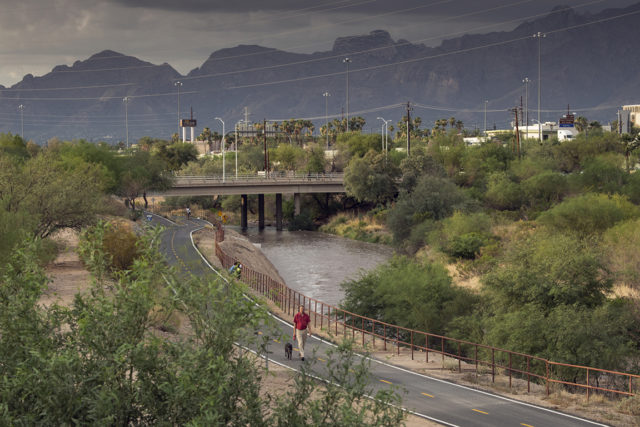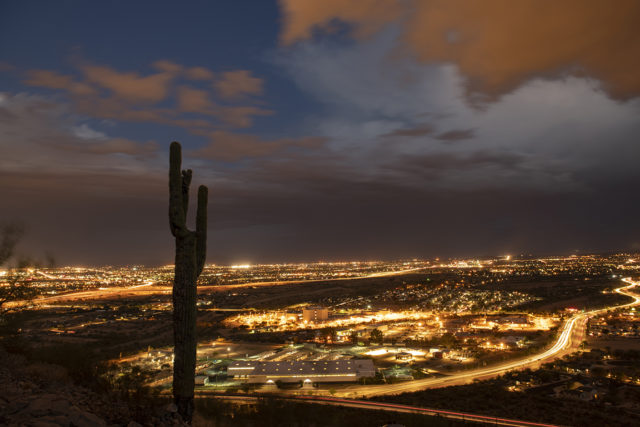A new flow for the Santa Cruz River in Downtown Tucson
On June 24th Tucson Water will launch the Santa Cruz River Heritage Project with the release of highly treated recycled water into the river in a new location close to downtown promoting the growth of Tucson’s valuable ecosystems and cultural landmarks. Join us at the Día de San Juan Fiesta as part of this event!
We sat down with Luke Cole, our associate director of Resilient Communities and Watersheds, for a quick FAQ on the Heritage Project and discussed what it means for community members, the Sonoran Institute, and water conservation in the Southwest.

Where is the water that will be allocated for this project coming from?
The Heritage Project utilizes recycled, reclaimed water. This is the wastewater that we flush down our toilet, shower, and sink drains that then gets treated at a high level at the Agua Nueva Wastewater Reclamation Facility and will be released in the river right around Silverlake Rd. (also called 29th Street).
Is this water clean, and will it support river habitat?
Fortunately, because of the technological upgrades that have occurred, we now have the luxury of being able to have very real, clean, and aquatically viable water back in the river. We have seen that this water can provide habitat for pollution-sensitive invertebrates and endangered fish, like the Gila topminnow that are able to thrive in shallow water, and sustain our willow and cottonwood trees in the other flowing stretches. The ability for this water to support sensitive plant and animal species speaks to its high quality. It’s likely to support plants and animals that wouldn’t otherwise be there.
Are there co-benefits for the community in terms of culture and historical preservation?
This is one of the most historically rich stretches in Tucson. It’s where Tucson gets its name and is deeply tied to Tucson’s cultural, agricultural, and ecological roots. The location near the base of ‘A’ Mountain (Sentinel Peak), I think, is very strategic and is ecologically smart, and culturally respectful and thoughtful.
The added amenity of water, even if it’s just a small ribbon is so much more attractive to either visitors or those who are already using those cultural spaces. The presence of water is a sort of an ecological trigger that jumpstarts the restoration of the ecosystem that is otherwise only there during storm events. A perennial water source will really enhance the vegetation and aesthetics, bringing interested people to experience the cultural amenities that the City, County, and the Tohono O’odham Nation have put so much effort into.
What does the Heritage Project mean for the Sonoran Institute, and does it impact the work that we do?
Yes, it does—we are the stewards of reporting on the conditions of the Santa Cruz River and our primary focus through the Living River report series has been on the wet stretches north of Nogales and Rio Rico, and the stretch that is just north of Tucson—both of which flow because of the introduction of wastewater. Now we will have a new stretch, and the Sonoran Institute recognizes the many co-benefits that will come to the community and the environment. We are poised to track and report those changes to Southern Arizona and beyond.

How do you think the community will respond to seeing water in the river, and how do you hope the region will respond?
This new flowing stretch is another jewel in the necklace of the Santa Cruz River. The vegetative, bird, fish, and insect reemergence, along with all of the aesthetic benefits that the water brings, will create gains for cultural resources, for tourism, and the economy.
There are already so many great amenities downtown, so I think that locals and newcomers will become aware of the holistic nature of the co-benefits benefits from this project. I think people will begin to see how amazing a little bit of water, especially if it’s persistent, can be.
The project is such a benefit for the region because many places don’t take full advantage of reclaiming water, and this allows us to get a second use and restore the river. It is a very reclaimable resource! We hope that this project will encourage other jurisdictions, if they have the means, to have as many perennially flowing stretches as possible leading to a more unified Santa Cruz River.
Blog Post By: Grace Wofford, Marketing Communications Intern
